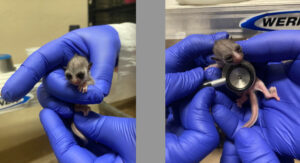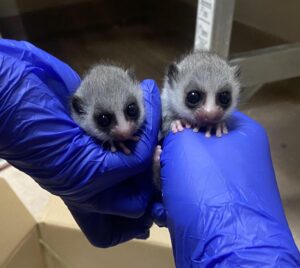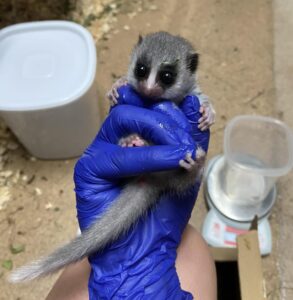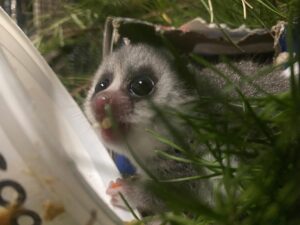
Fat-tailed dwarf lemur (Cheirogaleus medius) twins Roseate Spoonbill and Wood Stork, two days old. Photo by Madison A.
For the second time this baby season, we’re excited to announce twins!
On May 28, 2023, fat-tailed dwarf lemur mom Tottenham gave birth to one male and one female infant weighing 11.4 grams and 14 grams, respectively. This is Tottenham’s second set of infants with breeding partner Francolin since the pair were introduced in 2020. Welcome to the Duke Lemur Center, Roseate Spoonbill and Wood Stork!

Tottenham has been a fantastic mother so far! Photo by David Haring.
All of our fat-tailed dwarf lemur infants are named after species of birds. (Fun fact: we have a whole family of dwarf lemurs named after types of chicken!) Infants are named by the animal technician who cares for their family. Tottenham’s primary caretaker, a Florida native, chose two birds who reside in her home state. The Roseate Spoonbill (Platalea ajaja) is a gorgeous pink bird that makes its home in Florida’s marshes, and the Wood Stork (Mycteria americana) is a tall, white bird that towers over most wetland birds at around three feet tall.

Roseate Spoonbill and Wood Stork, 16 days old, are carefully handled by an animal technician for a routine weighing. Photo by Madison A.
Fat-tailed dwarf lemurs are unique within the primate family as the only species capable of hibernating for extended periods of time. Hibernation, which occurs during the dry season in Madagascar, can last up to seven months. During this time, fat-tailed dwarf lemurs enter a state called torpor, in which their heart rate drops from about 180 beats per minute to as low as eight beats per minute. Their body temperature drops, too, and becomes driven by the ambient temperature of the environment.
In preparation for hibernation, fat-tailed dwarf lemurs spend the wet season (when fruits and flowers are more abundant) accumulating fat in their tails by gorging on food. During their period of gorging, dwarf lemurs’ tails can reach up to 40% of the lemurs’ total body weight (hence the namesake “fat tail”). They then enter a state of hibernation, living off of the fat stored in their tails.

Roseate Spoonbill, affectionately nicknamed “Rosy” by our animal technicians, has grown significantly in her first month of life! Here, she is handled for another routine weighing at four weeks old. Photo by Madison A.

Five-week-old Wood Stork enjoys a snack of mushed banana and veggies. Photo by Madison A.

